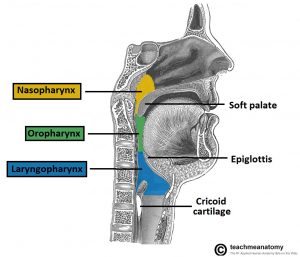Anatomy and Functions of PHARYNX and MCQs for NEET, Pharmacist & Drug Inspector Exams
ANATOMY OF PHARNYX
The Pharynx is a funnel shaped tube which is about 12 to 13 cm long. It extends from the posterior nares to the level of cricoid cartilage. The pharynx lies superior to the larynx (voice box) , posterior to the nasal and oral cavities and lastly anterior to the cervical vertebra. the wall of pharynx is made of skeletal muscle and lined by mucous membrane and because of the contraction in skeletal muscle, pharynx assists in deglutition i.e swallowing.
Further pharynx is divided in 3 portions to understand its anatomy more wisely. the 3 portions are
1. Nasopharynx
2. Oropharynx
3. Laryngopharynx.
Now we will study about these parts separately
- NASOPHARYNX:-the superior portion of pharynx lies posterior to nasal cavity and reaches till the soft palate. The soft palate is the arc shaped muscular partition which separates the nasopharynx and oropharynx. It contains 5 opening- 2 internal nares , 2 openings to the auditory tubes and 1 opening that leads to the oropharynx, other than these this part of pharynx also contain the pharyngeal tonsils(adenoids). Through the internal nares the air passes by this part.
- OROPHARYNX:- The middle portion of pharynx which extends from the soft palate till the hyoid bone and lies posterior to oral cavity. It only has 1 opening known as fauces which open into the mouth. Oropharynx work for both respiratory as well as digestive functions as it allows the passageway for air water and food, it is lined by non-keratinized squamous epithelium. Also it has two tonsils i.e lingual and palatine tonsils.
- LARYNGOPHARYNX:-the inferior portion of pharynx which begins from the hyoid bone. At its distal end it opens posteriorly at esophagus and anteriorly in the larynx. Like the oropharynx, laryngopharynx also works for both respiratory and digestive system and thatswhy it is also lined by non-keratinized squamous epithelium.

FUNCTIONS OF PHARYNX
There are 5 major functions of pharynx which are as follows:-
- Passageway for air and food-as studied earlier, the pharynx works for both respiratory and digestive system, as air passes through the nasal and oral cavities while food passes through oral and laryngeal sections.
- Warming and humidifying-as the air passes towards the lungs it is warmed and humified from all the regions that it crosses.
- Hearing-the auditory tube extends from the nasopharynx to each middle ear and allows the air to enter the middle ear. this makes the air in the middle ear be at the same pressure as in outer ear in order to protect the eardrum.
- Protection-the pharyngeal and laryngeal tonsils present produces antibodies against the swallowed or inhaled unwanted particle.
- Speech-the pharynx act as a resonating chamber for sound towards the larynx. It also helps along with sinuses of nasal cavity to give voice its individual characteristics.
MULTIPLE CHOICE QUESTIONS(MCQs)
1.How long is the pharynx?
A. 12cm B. 20cm
C. 5cm D. 18cm
2. Which structure is associated superiorly to the pharynx?
A. Cervical vertebra B. Inferior surface of skull
C. Larynx D. esophagus
3. What all are the part of pharynx?
A. Nasopharynx B. Laryngopharynx
C. Oropharynx D. All of the above
4. The pharynx functions as a protective region because of?
A. tonsils B. Sinuses
C. internal nares D. Opening to auditory tube
5. The portion of pharynx which extends to the hyoid bone is?
A. Nasopharynx B. tonsils
C. Laryngopharynx D. Oropharynx
6. Which of the following statement is NOT true?
A. The pharynx lies superior to larynx
B. the pharynx is funnel shaped tube
C. The nasopharynx is lined by mucous membrane
D. Sympathetic supply to the pharynx is done by vagus nerve
7. Which of the following is found in laryngopharynx?
A. Adenoids B. Palatine tonsil
C. Lingual tonsil D. None of the above
8. Match the following-
(a)superior portion of pharynx 1. Mucous membrane
(B)inferior portion of pharynx 2.nonkeratinized squamous epithelium
(C ) oropharynx is lined by
(d) nasopharynx is lined by 3.laryngopharynx
4. nasopharynx
9. The nasopharynx extend till?
A. Soft palate B. Internal nares
C. HYOID BONE D. Cricoid cartilage
10. The sympathetic supply to pharynx is done through which nerve?
A. Vagus nerve B. Glossopharyngeal nerve
C. Facial nerve D. Nerve from the superior cervical ganglia
ANSWERS:-
1. 12cm
2. inferior surface of skull
3. all of the above
4. tonsils
5. oropharynx
6. sympathetic supply is done by vagus nerve
7. none of the above
8. (A) – 4 (B) – 3 (C) – 2 (D) – 1
9. Soft palate
10. nerve from the superior cervical ganglia
Participate in Online FREE GPAT TEST: CLICK HERE
Participate in Online FREE Pharmacist TEST: CLICK HERE
Participate in Online FREE Drug Inspector TEST: CLICK HERE
REFERENCES:- 1. Ross and Wilson ; Anatomy and physiology of health and illness ; 12th edition page no.244-245
2.Gerard J Tortora; principles of anatomy and physiology ;12th edition; page no. 878-879.